

The "Device" page is where you create the gateway's identity as a BACnet device.
Clicking the ‘Get Info’ button will read all of the information shown on the left half on this page, except that no password is ever read out (not permitted by the device).
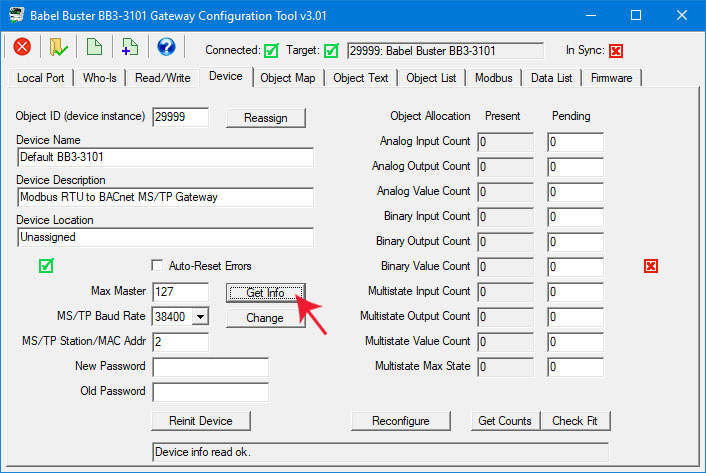
| Object ID | Object ID is the device instance of this gateway. It must be unique on the network. When a BACnet client broadcasts the "Who-Is" request, this number will be sent back as this device's identity. If more than one device respond with the same device instance, then the client will be unable to communicate correctly with the devices. |
| Device Name | This Device Name must be a unique name on your BACnet network. When a BACnet client broadcasts a "Who-Has" request asking for a device object by a given name, you will create problems on the network if more than one device responds with the same device name. Therefore, be careful to see that the name is unique. |
| Device Description | The Device Description property of the Device object is there for your own use in whatever way you see fit, and does not need to be unique. |
| Device Location | The Device Location property of the Device object is there for your own use in whatever way you see fit, and does not need to be unique. |
| Auto-Reset Errors |
Reliability codes will “latch” by default and require that you read the Reliability property in order to reset it to zero, assuming the problem has gone away. Once the non-zero reliability code has been read (by reading the Reliability property), it will reset to zero the next time the object is updated, provided the problem has been resolved. Since many systems do not automatically read Reliability codes, but do automatically respond to the Fault Status Flag associated with the non-zero reliability code, an auto-reset option is available. When set, reliability codes will return to zero as soon as the problem has been resolved, regardless of whether the non-zero reliability code was ever acknowledged by reading it. Many systems will report an object as "offline" because its fault status bit is set. It is not actually offline, and is in fact communicating just fine trying to tell you that there is a problem. But many front end systems don't recognize this and blindly claim "offline" as a result of the fault bit in the status property. If you are having this issue as the result of communication errors on the Modbus side, try setting the Auto-Reset Errors option here. |
| Max Master | The Max Master determines the highest device MAC address that the gateway (or any MS/TP device) will try to poll for. It will default to 127, and you should leave this set to 127 unless you know exactly why you are changing it. |
| MS/TP Baud Rate | MS/TP Baud Rate needs to be set to match whatever speed your MS/TP network is running at. The BB2-3010/3060 will support 9600, 19200, 38400, and 76800. |
| MS/TP Station or MAC Addr |
This is the MAC address of the gateway. The MAC address must be unique on the network. If more than one device is given the same MAC address, the MS/TP network will fail to function. Not only will this device fail to communicate, but the entire network will be corrupted by duplicate MAC addresses. |
| New Password | Use the New Password field if you want to change the default password to something else. Leave this field blank if you do not want to change the password. Any password in this window will take effect upon clicking the Change button. |
| Old Password | The Old Password is "buster" by default as shipped from the factory. You only need to use it when reinitializaing the device. |
Changes to any of the device information on the left-hand half of this page may be made. Once changes are made, click the ‘Change’ button to register all changes except device instance (see Reassign).
To cause changes such as baud rate, MAC address, or Max Master setting to take effect, it is necessary to reinitialize the device. The new parameters are saved, but not put into use until you reinitialize the device (enter Od Password and click Reinit Device button) or power cycle the gateway. This reinitialization is required so that you don't immediately lose contact with the device when changing baud rate or MAC address. When you change port parameters like baud rate, you will also need to restart to configuration tool at the different baud rate.

To change the Object ID (device instance) property, enter the new object ID (device instance) and click the ‘Reassign’ button.

Once you do this, you will need to return to the Who-Is page, clear the cache, repeat the Send Who-Is and Refresh, and reselect your target device. You will get an ‘unknown device’ error if you try to continue without reselecting the device since the device ID has now changed.
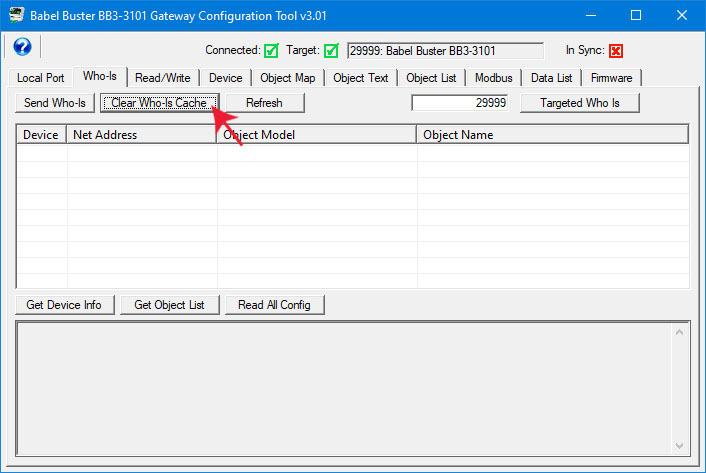
Repeat the device selection just as you did originally except now with the updated device instance.

You are now reconnected with your original device at its now device number. Click the Get Info button to re-read the device object properties just to verify that you are connected.
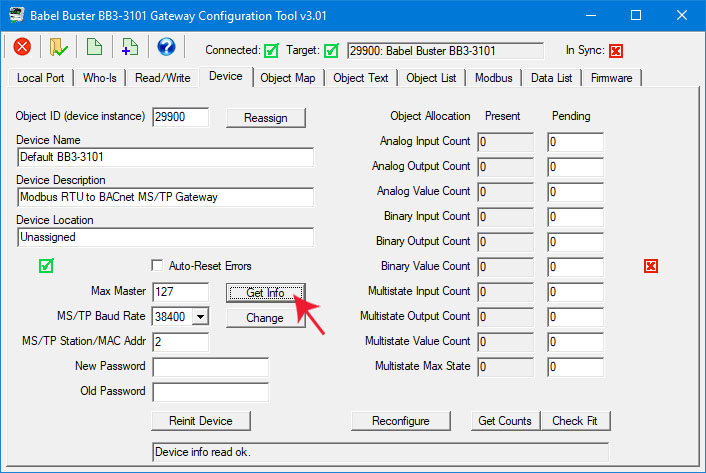
Click ‘Get Counts’ to read the present object allocation configured in the device. The counts will show up in the ‘Present’ column. This set of counts tells you how many of each type of object are currently defined in the device. If a BACnet client performs an "auto discovery", this determines how many of each type of object will be discovered.
If you are working offline, i.e. creating a configuration ahead of time without any device connected, then entire the desired object counts in the Pending column, and click Get Counts.
If you will be using Multistate objects, the maximum state value is also set at the bottom of the object count list.
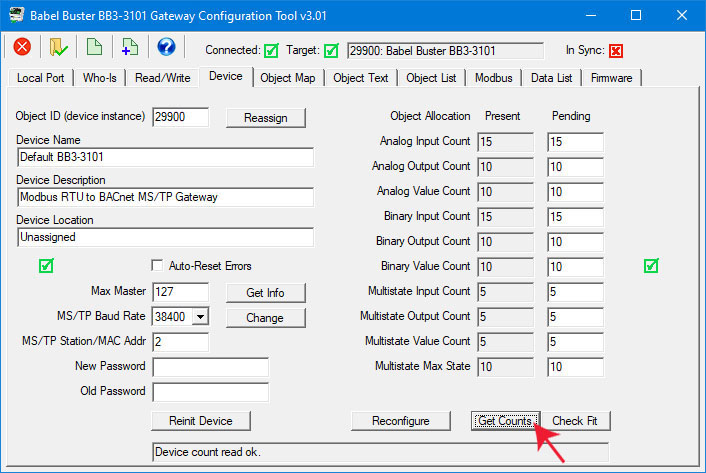
Enter new object counts in the windows in the ‘Pending’ column.
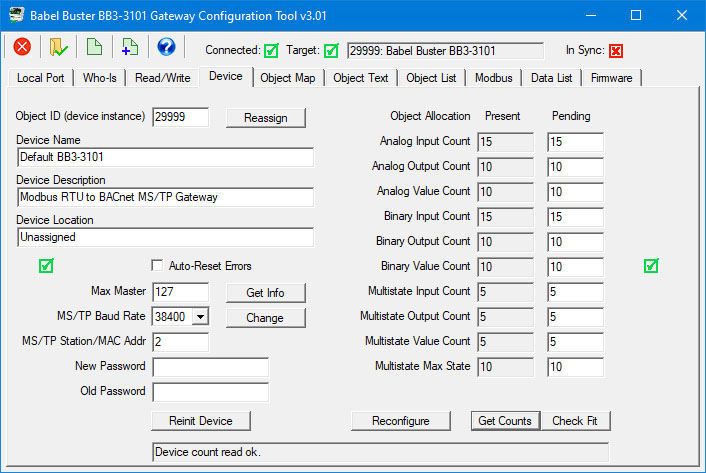
Click ‘Check Fit’ to check to see if the counts are valid. Refer to Section 3.6, Changing Object Counts, for additional examples.
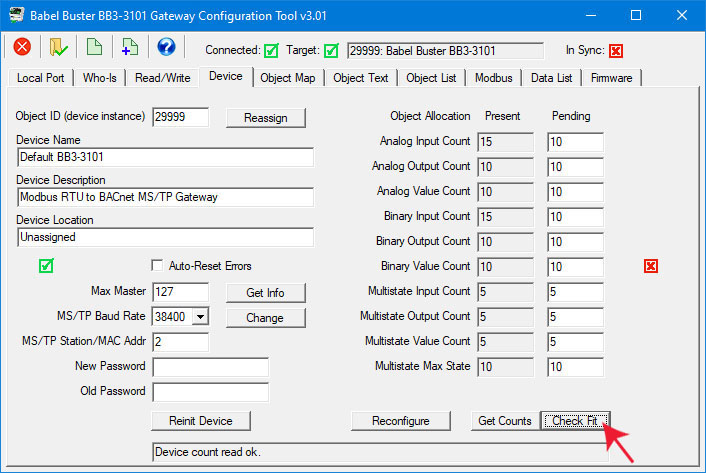
When you are ready to reconfigure the device with the new object allocation, click the ‘Reconfigure’ button. NOTE: This action will completely erase all prior object map configuration.
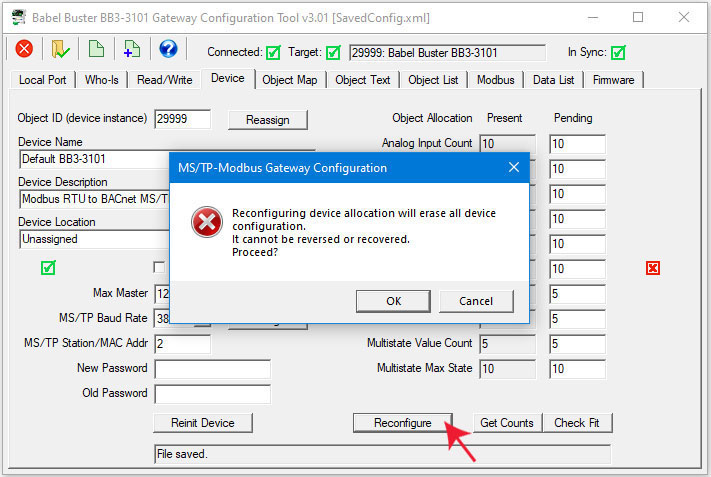
The configuration is now ready to be applied.
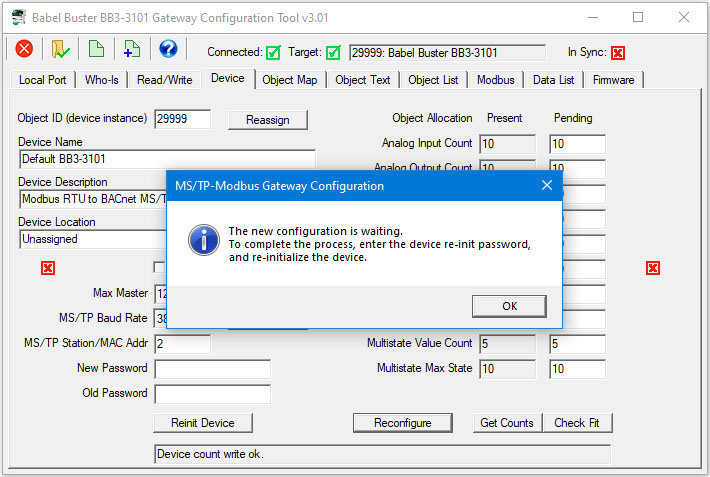
At this point, the desired new object counts have been sent to the gateway device, but the device has not yet implemented the change. You need to reinitialize the device to finalize the process. Enter the password (default is "buster") and click the Reinit Device button.

You can now click the Get Counts button again to verify the counts in the device. The numbers on the screen will be replaced with whatever is actually in the device, and if all went well, they will be what you thought you had asked for. But if you had failed to enter the correct password, your request was not executed (and there would have been an error message in the status window at the bottom of the screen).

Depending on what the previous object counts had been and what you are trying to change them to, you may get the error indicated in the log window at the bottom of the screen illustrated below. This message appears after clicking OK on the dialog box that appears when you click the Reconfigure button.

If you add up the object counts in the Pending column, the total does not exceed the maximum of 1024. So why is this error happening?
The writing of object counts from the configuration tool to the gateway is largely transparent - you just click the button. But what is really happening is that each count is a property value in the BACnet Device object in the gateway. To assure that any arbitrary object count can be written, it is necessary to re-process the total allocation as each new count value is written. When the first count of 980 in above example is written to request 980 Analog Input objects, the gateway is still retaining 120 Analog Output objects. That adds up to 1100, which is over the limit, and the result is the "invalid configuration" error reply.
In general, if counts higher on the list are trying to take away from counts lower on the list, you are likely to run into this problem. The solution is to temporarily assign zero objects all the way down the list. Repeat the object allocation with all zero counts as illustrated below.

Now go back and retry the counts that were previously not working. Pictured below is the successful reconfiguration that had previously failed above.

Click the New File icon to save your configuration to a new XML file. You have the option of saving only the device properties, or only the object maps, but the default (and most often preferred) option is to save both.
If you want to re-save a previously opened configuration file, following making some changes to configuration, click the first File icon rather than the second icon. The first green icon is "Save" and the second icon is "Save As", where "save as" means create a new file.
You have the option of saving just device properties, just object maps, or both. To copy object mapping to another gateway, you will usually want to save just the object maps. To create a full backup of the existing configuration for this gateway, save both.

When you click OK in the "Export to File" dialog, you will next be directed to the Windows file dialog where you may enter a name for your new file.
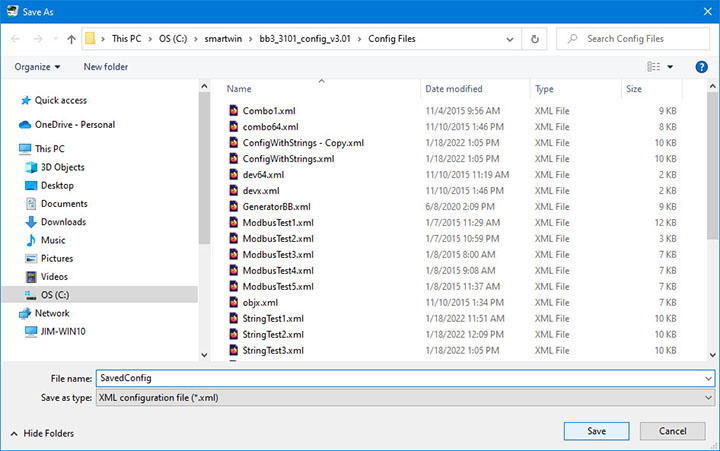
To load a previously saved configuration into the tool, slick the File Open icon. You will have the option of importing device properties, object maps, or the default both.
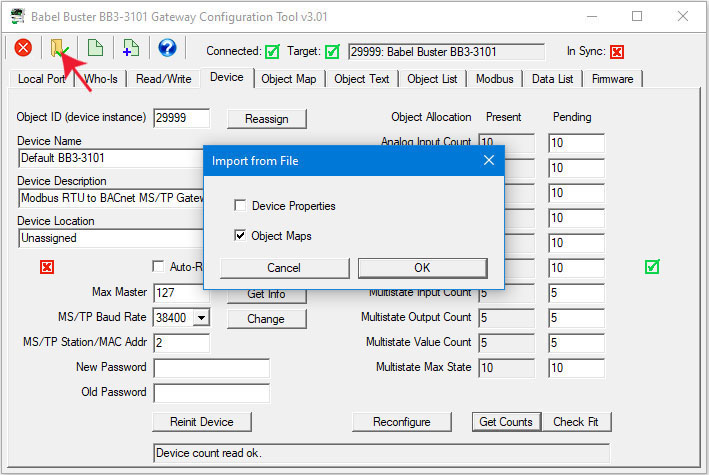
Upon clicking OK in the "Import from File" dialog, you will be directed to the familiar Windows file dialog where you can select the file to be opened.

To wipe the slate completely clean in the configuration tool. click the Clear icon, which is the first icon on the toolbar. You will be given the option of clearing device properties, object maps, or both. Or just click Cancel if you clicked the Clear icon by mistake.
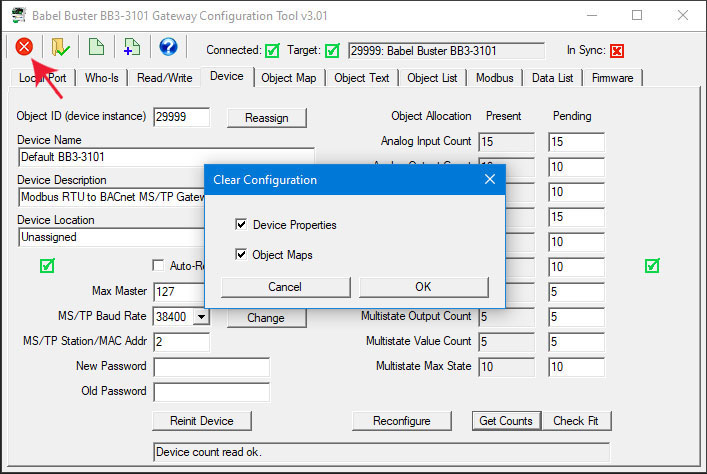
Clear everything will clear all but the device instnace.
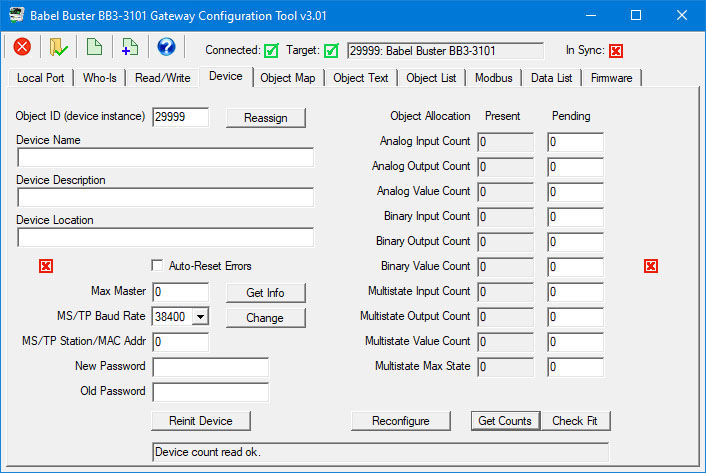
Note: If you have an XML configuration file saved from a BB2-3010, you can directly import that into your BB3-3101 by simply opening that file on this page.